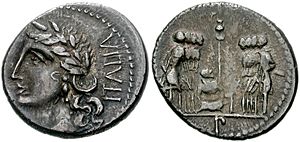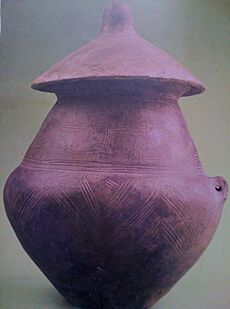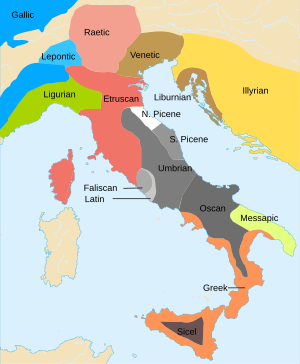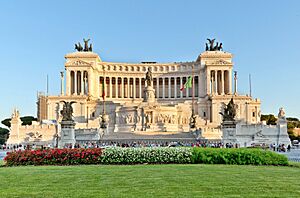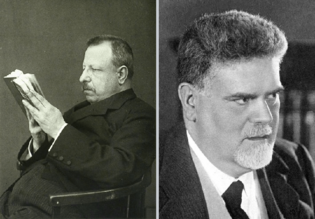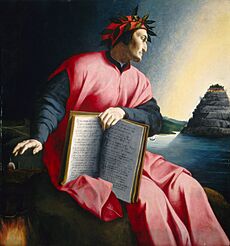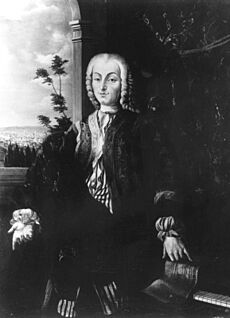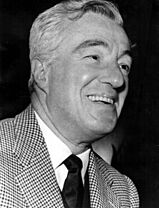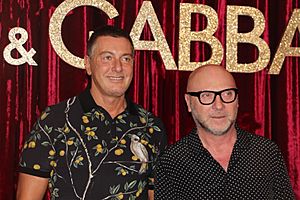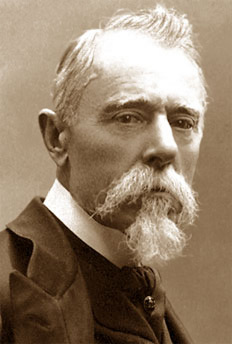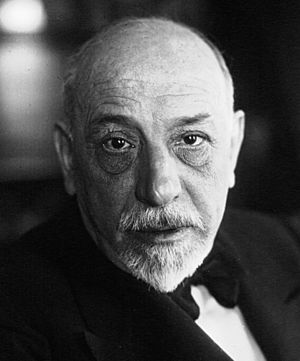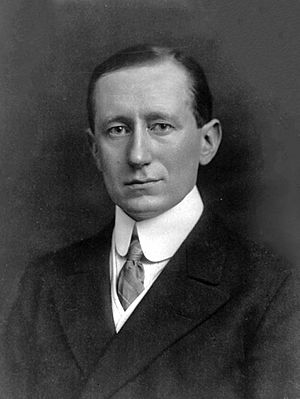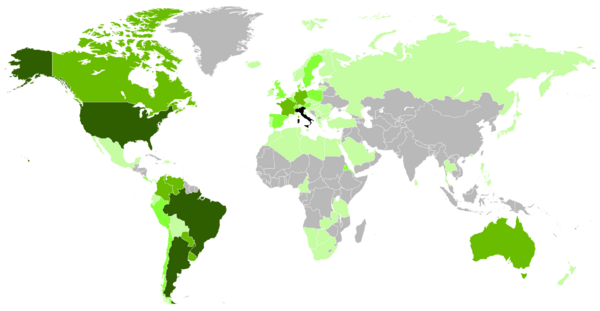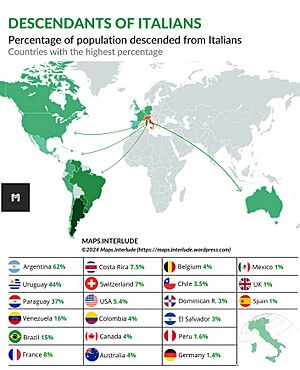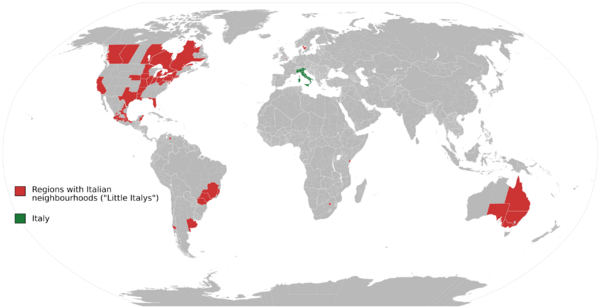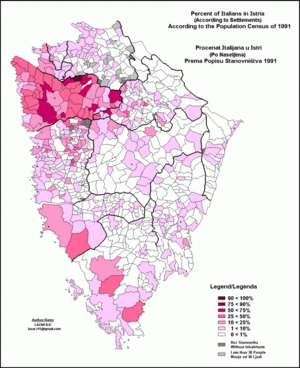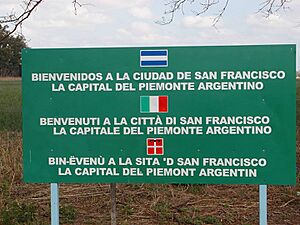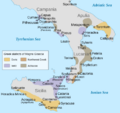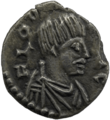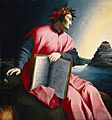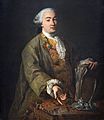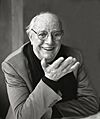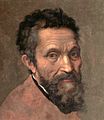Italians facts for kids
| Italian: Italiani | |
|---|---|
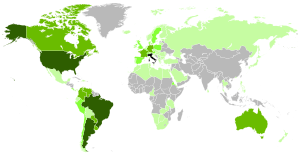 |
|
| Total population | |
c. 140 million
|
|
| Regions with significant populations | |
| Italy 55,551,000 | |
| Brazil | 25–34 million (incl. ancestry) |
| Argentina | 20–25 million (incl. ancestry) |
| United States | 16–23 million (incl. ancestry) |
| France | 5–6 million (incl. ancestry) |
| Paraguay | 2.5 million (incl. ancestry) |
| Colombia | 2 million (incl. ancestry) |
| Canada | 1.5 million (incl. ancestry) |
| Uruguay | 1.5 million (incl. ancestry) |
| Venezuela | 1–2 million (incl. ancestry) |
| Australia | 1.1 million (incl. ancestry) |
| Germany | 801,082 |
| Switzerland | 639,508 |
| Chile | 600,000 |
| Peru | 500,000 |
| Belgium | 451,825 |
| Costa Rica | 381,316 |
| Spain | 350,981 |
| United Kingdom | 280,000 |
| Mexico | 85,000 |
| South Africa | 77,400 |
| Ecuador | 56,000 |
| Russia | 53,649 |
| Netherlands | 52,789 |
| Austria | 38,904 |
| San Marino | 33,400 |
| Luxembourg | 30,933 |
| Portugal | 30,819 |
| Ireland | 22,160 |
| Croatia | 19,636 |
| Sweden | 19,087 |
| Albania | 19,000 |
| United Arab Emirates | 17,000 |
| Israel | 16,255 |
| Greece | 12,452 |
| Denmark | 10,092 |
| Poland | 10,000 |
| Thailand | 10,000 |
| Languages | |
| Italian and other languages of Italy | |
| Religion | |
| Mostly Roman Catholicism Some Irreligion |
|
| Related ethnic groups | |
| Corsicans, Sammarinese, Sicilians, Sardinians, Maltese people | |
Italians (Italian: italiani) are a group of people who originally come from the Italian geographical region. They share a common culture, history, and often speak the Italian language or other regional Italian languages.
The idea of "Italy" and "Italian" has been around since ancient times. Early people in Italy included the Etruscans, Ligures, Adriatic Veneti, Sicani and Siculi (in Sicily), and the Latins, who were the Romans. The Romans united Italy and made it the center of a huge empire.
Later, in the Middle Ages, groups like the Ostrogoths, Lombards, Franks, Normans, and Arabs came to Italy. They became part of Italian culture. In more recent times, countries like France, Spain, and Austria also controlled parts of Italy. All these groups influenced Italian culture, history, and local languages. Also, people moving in and out of Italy helped shape local cultures.
Today, if you are an Italian citizen, you are a national of Italy. This is true no matter where your family came from or where you live. Italian citizenship is often passed down through family (called jus sanguinis, or "right of blood"). This means if your ancestors were Italian citizens, you might be able to claim citizenship too. It's thought that about 80 million people could claim Italian citizenship, even though only about 55 million are currently citizens.
Most Italian citizens speak Italian, which is a Romance language from the Indo-European family. It grew from the Tuscan dialects. Many Italians also speak a regional or minority language that existed in Italy before the national language. Standard Italian became common across the country after Italy became a united kingdom in 1861. Before that, local dialects were more widely spoken. Because of this, and Italy's history of being divided, Italian culture and traditions can be different from one region to another.
Besides the 55 million Italians living in Italy, many Italian-speaking groups live in nearby countries. About half a million are in Switzerland, and all the people in San Marino speak Italian. There are also groups in Croatia and Slovenia (like the Istrian Italians) and Montenegro (like the Dalmatian Italians). Because many Italians moved away in the late 1800s and early 1900s, over 80 million people worldwide have some Italian family background. This includes many people in Argentina, Uruguay, Brazil, the United States, Canada, Australia, and parts of Europe.
Italians are known for being very connected to their families and local communities. They have made huge contributions to many areas like arts, music, science, technology, fashion, movies, food, and sports.
Contents
What's in a Name? The Meaning of "Italia"
There are many ideas about where the name Italia came from. One idea is that it came from an Ancient Greek word for the land of the Italói. This was a tribe in a region now called Calabria. Some scholars think their special animal was the calf (vitulus in Latin). Other ancient writers said Italy was named after a local ruler called Italus.
At first, the ancient Greek term "Italia" only referred to a small part of southern Italy. Over time, the name grew to include more areas. Before the Roman Republic expanded, Greeks used "Italia" for the land between the strait of Messina and the gulfs of Salerno and Taranto.
The borders of Roman Italy are clearer. An ancient writer named Cato described Italy as the whole peninsula south of the Alps. By 264 BC, Roman Italy stretched from the Arno and Rubicon rivers in the center-north all the way to the south. The northern area, Cisalpine Gaul, was later added to Italy in 42 BC. Islands like Sardinia, Corsica, Sicily, and Malta were added in 292 AD. This made ancient Italy almost the same as modern Italy.
The Latin word Italicus meant "a man of Italy," different from someone from a Roman province. The word italianus, from which "Italian" comes, was used later. After the fall of the Western Roman Empire, new kingdoms were formed in Italy. The name Italia was kept for these kingdoms.
A Look at Italian History
Italian people today have a mix of different backgrounds. This is because many groups moved into the Italian peninsula over time. Also, Italy is in the middle of the Mediterranean Sea, which made it a crossroads for many cultures.
The earliest people in Italy during the Iron Age included groups like the Etruscans and Ligures. There were also Indo-European-speaking peoples, such as the Celts in northern Italy and the Italic peoples throughout the peninsula. A large number of Greeks settled in southern Italy, a region known as "Magna Graecia" (Greater Greece). Over time, Sicilians were also influenced by the Normans.
Italians mostly come from these early groups. Like other people in southern Europe who speak Romance languages, they share a common Latin background. There are also traces of people from the Middle East and North Africa in their genes, especially in central and southern Italy.
Early People and Migrations
Like most Europeans, Italians largely come from three main groups:
- Mesolithic hunter-gatherers: These were early people who hunted and gathered food.
- Neolithic Early European Farmers: These farmers came from Anatolia (modern-day Turkey) about 9,000 years ago.
- Yamnaya culture|Steppe pastoralists: These herders came from Ukraine and southern Russia about 5,000 years ago.
The first modern humans came to Italy around 35,000 to 40,000 years ago. Italy was a safe place during the Ice Age, and from there, early humans later spread across Europe.
Around 10,000 years ago, farming began to spread from Western Asia and the Middle East to Europe, including Italy. This change had a big impact, especially in southern and eastern Europe.
Later, in the early Bronze Age, people who spoke Indo-European languages began to move into Italy from Central Europe. These included the Bell Beaker culture. From the 14th century BC, other groups, like the Italo-Celts, arrived. DNA studies show that people from the Steppe arrived in northern Italy by 2000 BCE and in Central Italy by 1600 BCE.
In the Iron Age, Celtic cultures spread across much of Italy. Italic peoples lived in northeastern, southern, and central Italy. The "West Italic" group, including the Latins, were among the first. They buried their dead by burning them and had advanced metal skills.
Before the Romans
By the start of the Iron Age, the Etruscans were the most powerful group in Italy. They lived in what is now Tuscany, western Umbria, and northern Lazio. They also spread into the Po Valley and other areas. Modern research shows that the Etruscans were native to Italy and had genes similar to their Latin neighbors.
The Ligures were another very old group in Italy and Western Europe. They lived in areas like Liguria and Piedmont. Their language was similar to both Italic and Celtic languages. They might have once lived in a much larger part of Italy, even as far south as Sicily.
Before Roman rule, many different peoples lived in modern Italy and its islands:
- Etruscans (including Camunni, Lepontii, Raeti)
- Sicani
- Elymians
- Ligures
- Italics (like the Latins, Umbri, Osci, and Sicels)
- Iapygians (including Messapians, Daunians, Peucetians)
- Celts (like the Boii and Cenomani)
- Greeks in southern Italy
- Sardinians in Sardinia
Most of Italy was home to Italic tribes. Sicily also had the Sicani and Elymians. The Veneti lived in the Veneto region.
Starting in the 8th century BC, Greeks came to Italy and built cities along the coast of southern Italy and eastern Sicily. This area became known as Magna Graecia ("Greater Greece"). The Greeks often fought with the local Italic tribes. However, they also shared their culture and influenced many local people.
The Gauls crossed the Alps and invaded northern Italy in the 4th and 3rd centuries BC. They settled in an area called Cisalpine Gaul. Even though it was named after the Gauls, this region was mostly home to local tribes like the Ligures and Etruscans.
Roman Times to the Middle Ages
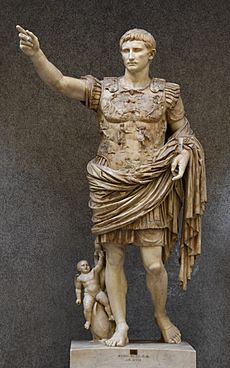
The Romans started as three main tribes: Latins, Sabines, and Etruscans. They went on to conquer the entire Italian peninsula. During the Roman period, many cities and colonies were built across Italy, such as Florence, Turin, and Verona. At first, Latins settled these cities, but later, other Italic tribes who had adopted Latin culture also joined. After the Roman conquest, "all of Italy had become Latinized."
After the Romans conquered Cisalpine Gaul, they established many colonies there. Roman and Italic people settled in these areas. For example, Bologna and Modena were Roman colonies. The Boii, a powerful Gallic tribe, were expelled by the Romans and moved to Bohemia.
Augustus was the first to create an official region called Italia, stretching from the Alps to Sicily. He called its people "Italicus populus." Because of this, some historians call him the "Father of Italians."
People often moved between different regions during Roman times. For example, many Picentes were moved to Campania. Also, 47,000 Ligures were moved from their homes to Samnium. These movements helped Italy quickly become Romanized and Latinized.
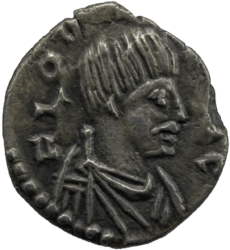
In 476 AD, a large group of Germanic tribes, led by Odoacer, invaded and settled in Italy. Before them, other Germanic groups like the Alemanni and Burgundians had also settled in Italy. The Ostrogoths, led by Theoderic the Great, conquered Italy. They tried to mix Roman and Gothic cultures. Since Italy had millions of people, the Goths were a small addition to the population. After a war that harmed the local people, the Ostrogoths were defeated.
In the 6th century, another Germanic tribe called the Longobards invaded Italy. They were a small group compared to Italy's population at the time. Later, the Bavarians and Franks conquered and ruled most of Italy. Some Slavs settled in northern Italy, and Bulgars settled in central Italy.
After Roman rule, Sicily, Corsica, and Sardinia were conquered by different groups, including the Vandals, Ostrogoths, and Byzantines. Sardinia became independent with its own kingdoms. Corsica was influenced by the Lombards and later by the cities of Pisa and Genoa. Sicily became an Emirate of Sicily under Arab rule. Later, the Normans took over Sicily and established the Kingdom of Sicily. Many Normans and people from northern Italy (called Lombards) moved to Sicily, changing its population.
From Renaissance to Today
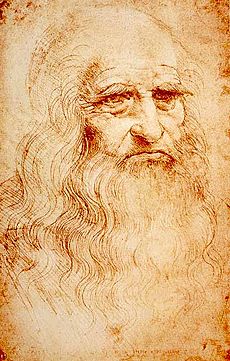
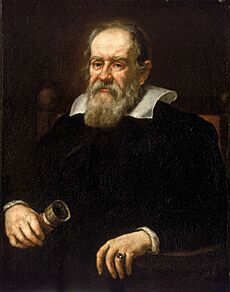
From the 11th century, Italian cities grew quickly in importance. They became centers for politics, banking, and trade. Many, like Florence, Rome, Genoa, and Venice, became rich and almost independent city-states. They each had their own foreign policies and resisted control by nobles and foreign powers.
During the rule of Frederick II, Holy Roman Emperor, many Moors (Muslims) were removed from Sicily. To repopulate the island, people from northern Italy and France were invited to settle there. This brought back a Latin influence to Sicily. It is believed that about 200,000 Lombard immigrants settled in Sicily over a few centuries.
Italian dialects began to form from Vulgar Latin around the 12th century. Modern standard Italian comes from the written language of Tuscan writers in the 12th century. Writers like Dante Alighieri helped make Italian a respected literary language.
In the 14th and 15th centuries, some Italian city-states were among the most important powers in Europe. Venice, for example, was a major sea power. These city-states helped bring goods from the Byzantine and Islamic empires to Europe. This greatly helped the Renaissance, which started in Florence in the 14th century. The Renaissance led to a huge growth in arts, literature, music, and science.
More people from northern Italy continued to move to Naples, Rome, and Palermo in the 16th and 17th centuries. Also, smaller groups of Slavs and Arbereshe (Albanians) settled in Italy. Albanian soldiers were invited to Italy by the King of Naples to help defend the Christian religion. These groups helped repopulate villages that had been emptied by disasters.
The descendants of these Albanian immigrants, many of whom still speak the Arbëresh dialect, live throughout southern Italy today.
Italian Culture and Traditions
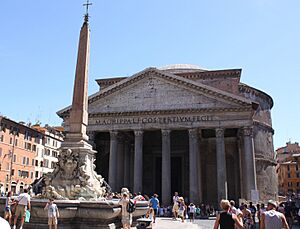
Italy is seen as one of the birthplaces of Western civilization. Italian culture is very rich and diverse, covering the entire Italian Peninsula and the islands of Sardinia and Sicily. Italy has been the starting point for many important global movements. These include the Roman Republic, the Roman Empire, the Roman Catholic Church, the Renaissance, the Scientific revolution, and the Baroque art style.
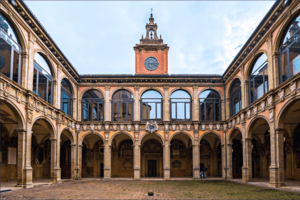
Italy also became a center of learning with the University of Bologna, founded in 1088 AD. It is the oldest university that is still running. Many other Italian universities followed. These learning centers helped start the Rinascimento, or Renaissance. The European Renaissance began in Italy and spread across Europe through Italian artists, scientists, and writers. Italy continued its cultural leadership through the Baroque period and into the Romantic period.
Because Italy was united late as a country, many Italian traditions are linked to their specific regions. Even with these regional differences, Italy has made huge contributions to Western culture. Famous parts of Italian culture include its opera and music, its amazing food (which is popular worldwide), its movies, its art collections, and its fashion. Milan and Florence are known as major fashion capitals.
Traditions of Italy are the beliefs and customs of Italian people. These traditions have been practiced for centuries and are still important today. Italian traditions are directly connected to Italy's history. Folklore of Italy includes traditional stories, dances, and music.
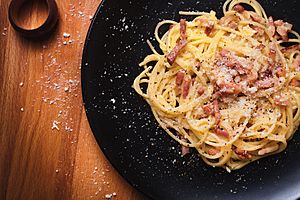
Italian cuisine is a Mediterranean cuisine with ingredients and cooking methods developed in Italy since ancient times. It then spread worldwide with Italian people who moved away. Italian cuisine has traditions common to the whole country, but also many regional differences, especially between northern, central, and southern Italy. Many dishes that were once only local are now popular across the country.
One key feature of Italian cooking is its simplicity. Many dishes use only a few ingredients. Italian cooks often focus on the quality of the ingredients rather than complex preparations. Many popular dishes were created by everyday people, not just chefs. This is why many Italian recipes are good for home cooking, using fresh, local ingredients.
Italian Philosophy and Ideas

Italian literature has greatly influenced Western philosophy, from ancient Greek and Roman times to the Renaissance and modern philosophy.
In the Middle Ages, Italian philosophy was mainly Christian. Important thinkers like St. Thomas Aquinas were part of this. Aquinas brought back Aristotle's philosophy to Christianity. He believed that faith and reason could work together.
The Age of Enlightenment also affected Italy. This movement, which followed the Renaissance, changed Italian philosophy. Thinkers often met in private groups in cities like Milan, Rome, and Venice. Universities in Padua, Bologna, and Naples were also important centers of learning. Philosophers like Giambattista Vico are seen as founders of modern Italian philosophy. Italian society changed a lot during this time. Rulers like Leopold II of Tuscany even ended the death penalty. It was a time of great new ideas and inventions. Scientists like Alessandro Volta and Luigi Galvani made important discoveries. Cesare Beccaria was a great writer who argued against torture and the death penalty.
In the late 19th and 20th centuries, important ideas in Italy included anarchism, communism, socialism, futurism, and fascism. Giovanni Gentile was a key philosopher of Italian fascism. While anarchism, communism, and socialism didn't start in Italy, they became very popular there. Italy produced many important thinkers in these areas. Antonio Gramsci is still an important philosopher in Marxist theory.
Early Italian feminists included Sibilla Aleramo and Anna Maria Mozzoni. Earlier writers like Christine de Pizan also touched on feminist ideas. Italian doctor and educator Maria Montessori created the Montessori philosophy of education, which is used worldwide. Giuseppe Peano was a founder of analytic philosophy.
Italian Literature
Formal Latin literature began in 240 BC with the first play in Rome. Latin literature, with writers like Virgil and Ovid, has greatly influenced the world. The Romans were also known for their oral stories, poetry, and plays. In the early 13th century, St. Francis of Assisi was considered the first Italian poet.
Italian literature goes back to the Middle Ages. The most important poets of that time were Dante Alighieri, Petrarch, and Giovanni Boccaccio. During the Renaissance, humanists like Niccolò Machiavelli collected old manuscripts. Many worked for the Church or as lawyers, which gave them access to book-copying workshops.

In the 18th century, Italian states improved, and philosophers shared their ideas across Europe during the Age of Enlightenment. Apostolo Zeno and Metastasio were notable writers. Carlo Goldoni created a new style of comedy. Giuseppe Parini was a leading figure in the 18th-century Italian literary revival.
Giacomo Leopardi was a remarkable poet in the early 19th century. Alessandro Manzoni was a key figure in Italian literature, known for his historical novel I promessi sposi. Later writers like Italo Svevo and Luigi Pirandello (who won the Nobel Prize in Literature in 1934) explored new ideas about reality.
Modern literary figures and Nobel Prize winners include Giosuè Carducci (1906), Grazia Deledda (1926), Luigi Pirandello (1934), Salvatore Quasimodo (1959), Eugenio Montale (1975), and Dario Fo (1997).
Italian Theatre
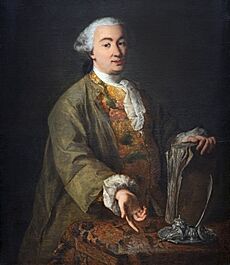
Italian theatre has roots in the Middle Ages, going back to the ancient Greek colonies in southern Italy and ancient Roman theatre. In the Middle Ages, theatre developed from Catholic church plays and pagan festivals. The Renaissance brought back the study of classical plays. This led to the modern idea of theatre: a performance in a special place for an audience. In the late 15th century, Ferrara and Rome were important centers for theatre.

From the 16th to 18th centuries, commedia dell'arte was a popular form of improvisational theatre. Traveling groups of actors would perform outdoors, doing juggling, acrobatics, and funny plays. These plays used a basic storyline, called canovaccio, and actors would make up the rest as they went along. The characters were often fixed types, like foolish old men or tricky servants, each with their own special costume.
The Ballet dance style also started in Italy. It began in Italian Renaissance courts as part of grand celebrations like weddings. Musicians and dancers worked together to create amazing shows. Over time, ballets became a regular part of theatre life.
Important Italian theatre actors and playwrights include Carlo Goldoni, Eduardo De Filippo, and Dario Fo.
Italian Cuisine
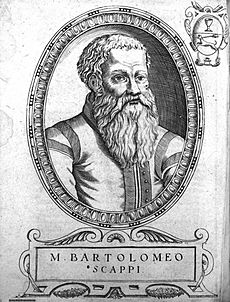
Italian cuisine is a Mediterranean cuisine that includes ingredients, recipes, and cooking methods developed in Italy since Roman times. It later spread worldwide with Italian people who moved to other countries. Italian cuisine has strong traditions across the country, but also many regional differences, especially between northern, central, and southern Italy. Many dishes that were once only regional are now popular everywhere.
Italian cuisine is known for its simplicity. Many dishes use only a few ingredients. Italian cooks often focus on the quality of the ingredients rather than making complex preparations. The most popular dishes were often created by everyday people, not just chefs. This means many Italian recipes are easy to make at home, using fresh, local ingredients from the region where the dish came from.
Famous Italian chefs include Bartolomeo Scappi, Gualtiero Marchesi, and Massimo Bottura.
Italian Visual Art
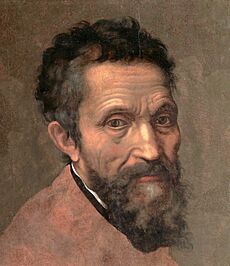
The history of Italian visual arts is very important to Western painting. Roman art was influenced by Greek art but also had its own unique style. The only Roman paintings that still exist are wall paintings, many from villas in southern Italy. These paintings show early examples of trompe-l'œil (trick of the eye) and landscape art.
Panel painting became more common during the Romanesque period, influenced by Byzantine art. By the mid-13th century, medieval art and Gothic painting became more realistic. Artists like Cimabue and his student Giotto started to show volume and perspective in Italy.

The Italian Renaissance (roughly 14th to mid-17th centuries) is often called the golden age of painting. Artists like Leonardo da Vinci, Michelangelo, and Raphael improved painting greatly. They used perspective, studied human anatomy, and developed advanced drawing and painting techniques. Michelangelo was also a famous sculptor, known for his David and Pietà. Other Renaissance sculptors include Donatello and Filippo Brunelleschi.
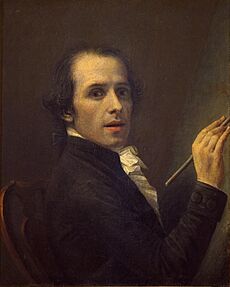
In the 15th and 16th centuries, the High Renaissance led to a style called Mannerism. Mannerist artists looked for instability and doubt, unlike the balanced art before them.
In the 17th century, important Italian Baroque painters included Caravaggio and Artemisia Gentileschi. Later, in the 18th century, Italian Rococo art was inspired by French Rococo. Artists like Giovanni Battista Tiepolo were famous. Italian Neoclassical sculpture focused on ideal beauty.
In the 19th century, major Italian Romantic painters included Francesco Hayez. Impressionism came to Italy through the Macchiaioli group. In the 20th century, with Futurism, Italy became important again for art. Artists like Umberto Boccioni and Giacomo Balla were key figures. Futurism was followed by the metaphysical paintings of Giorgio de Chirico, which influenced later artists.
Italian Architecture
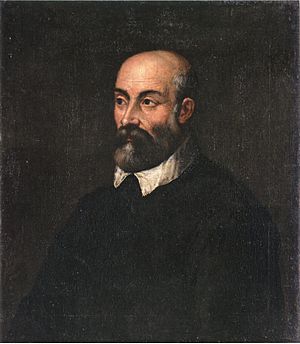
Italians are known for their amazing buildings. They built arches, domes, and other structures during ancient Rome. They also started the Renaissance architectural movement and were the home of Palladianism. This style influenced buildings around the world, especially in the UK, Australia, and the US.
Some of the most beautiful buildings in Western architecture are in Italy. These include the Colosseum, the Milan Cathedral, the Florence cathedral, and the Leaning Tower of Pisa. The unique buildings of Venice are also famous.
Italian architecture has influenced buildings worldwide. British architect Inigo Jones brought Italian Renaissance ideas to England in the 17th century. Italianate architecture, a style popular since the 19th century, describes buildings outside Italy that look Italian.
Italian modern and contemporary architecture refers to buildings from the 20th and 21st centuries. During the Fascist period, the "Novecento movement" brought back ideas from imperial Rome. Marcello Piacentini created a "simplified Neoclassicism." Later styles included Neoliberty and Brutalist architecture.
Italian Music
Music has always been a big part of Italian culture, from folk music to classical music. Instruments like the piano and violin were invented in Italy. Many classical music forms, such as the symphony and sonata, started with Italian music in the 16th and 17th centuries.
Famous Italian composers include Giovanni Pierluigi da Palestrina, Claudio Monteverdi, Antonio Vivaldi, Niccolò Paganini, Gioachino Rossini, Giuseppe Verdi, and Giacomo Puccini. Puccini's operas, like La bohème and Madama Butterfly, are among the most performed worldwide. Modern Italian composers like Luciano Berio helped develop experimental and electronic music.
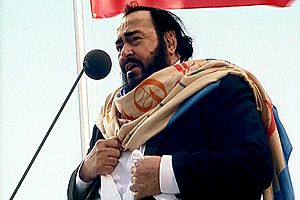
Italians are known as the founders of opera. Italian opera began in the early 17th century in cities like Mantua and Venice. Later, operas by composers like Rossini, Verdi, and Puccini became world-famous. The La Scala opera house in Milan is one of the best in the world. Famous Italian opera singers include Enrico Caruso.
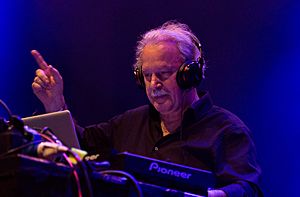
Jazz became popular in Italy in the 1920s. Today, Milan, Rome, and Sicily are important jazz centers. In the 1970s, Italy was a leader in progressive rock. Italy was also important in the development of disco and electronic music, with Italo disco being an early electronic dance genre.
Producers like Giorgio Moroder were very influential in creating EDM. Today, Italian pop music is celebrated at the Sanremo Music Festival. Singers like Mina, Andrea Bocelli, and Laura Pausini are famous internationally.
Italian Cinema (Movies)
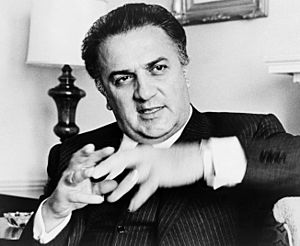
Since the Italian film industry started in the early 1900s, Italian filmmakers and actors have been very successful and influenced movies worldwide. The history of Italian cinema began shortly after the Lumière brothers showed their first films. Vittorio Calcina filmed Pope Leo XIII in 1896, becoming the first Italian director. In the 1910s, the Italian film industry grew fast. Cabiria (1914) is the most famous Italian silent film.
After a decline in the 1920s, Italian film was revived in the 1930s with sound film. A popular genre was the Telefoni Bianchi, comedies with glamorous settings.
A new era began after World War II. Italian films became widely recognized and exported. Famous directors from this time include Vittorio De Sica, Federico Fellini, Sergio Leone, and Roberto Rossellini. Their movies, like Bicycle Thieves and La dolce vita, are considered world cinema treasures. The mid-1940s to early 1950s was the peak of neorealist films, which showed the difficult conditions in post-war Italy. Actresses like Sophia Loren became international stars.
Since the early 1960s, Italian cinema also popularized many genres, like peplum and spaghetti Westerns. Sergio Leone's Dollars Trilogy, with music by Ennio Morricone, was very popular. In recent years, directors like Giuseppe Tornatore and Roberto Benigni have brought new success to Italian cinema.
The Venice International Film Festival, started in 1932, is the oldest film festival in the world. Italy has won the most Academy Awards for Best Foreign Language Film, with 14 awards. Italian films have also won many awards at other major festivals like Cannes and Berlin.
Italian Fashion and Design
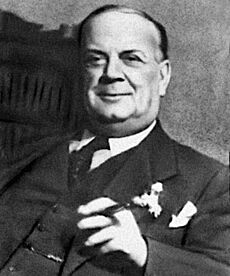
Italian fashion has a long history. Milan, Florence, and Rome are Italy's main fashion capitals. Milan is often seen as the fashion capital of Italy because many famous designers are based there.
The Italian fashion industry is a very important part of the country's economy. Major Italian fashion brands, like Gucci, Armani, Prada, Versace, and Dolce & Gabbana, are known as some of the best in the world.
Accessory and jewelry brands like Bulgari and Luxottica (the world's largest eyewear company) were also founded in Italy. The fashion magazine Vogue Italia is considered one of the most respected fashion magazines globally.
Italy is also a leader in design, including interior design, architectural design, and industrial design. The country has produced famous furniture designers like Gio Ponti. Italian phrases like Bel Disegno (beautiful design) are used in furniture design.
Italy is known worldwide for setting trends in design. Today, Milan and Turin are leaders in architectural and industrial design. Milan hosts FieraMilano, Europe's biggest design fair.
Famous Italian fashion designers include Guccio Gucci, Giorgio Armani, Gianni Versace, and Domenico Dolce.
Nobel Prizes Won by Italians
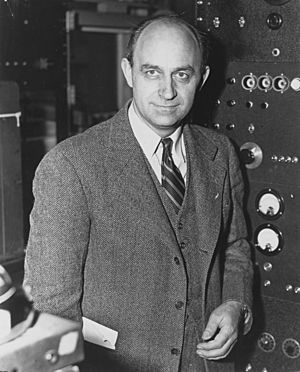
Italians have won many Nobel Prizes for their important contributions to literature, science, and peace. Here are some of them:
| Year | Winner | Field | Contribution |
|---|---|---|---|
| 1906 | Giosuè Carducci | Literature | For his powerful and beautiful poetry. |
| 1906 | Camillo Golgi | Medicine | For his work on the structure of the nervous system. |
| 1907 | Ernesto Teodoro Moneta | Peace | For his efforts to promote understanding between France and Italy. |
| 1909 | Guglielmo Marconi | Physics | For his work in developing wireless telegraphy (radio). |
| 1926 | Grazia Deledda | Literature | For her writings that show life on her home island with depth and sympathy. |
| 1934 | Luigi Pirandello | Literature | For his bold and clever changes to dramatic and stage art. |
| 1938 | Enrico Fermi | Physics | For discovering new radioactive elements and nuclear reactions. |
| 1957 | Daniel Bovet | Medicine | For his discoveries about compounds that affect body substances. |
| 1959 | Salvatore Quasimodo | Literature | For his poetry that expresses the tragic experiences of modern life. |
| 1959 | Emilio Gino Segrè | Physics | For discovering the anti-proton. |
| 1963 | Giulio Natta | Chemistry | For his discoveries in the chemistry and technology of high polymers. |
| 1969 | Salvatore Luria | Medicine | For his discoveries about how viruses copy themselves and their genetic structure. |
| 1975 | Renato Dulbecco | Medicine | For his discoveries about how tumor viruses interact with cell genes. |
| 1975 | Eugenio Montale | Literature | For his unique poetry that interprets human values with a realistic view of life. |
| 1984 | Carlo Rubbia | Physics | For his key contributions to finding the W and Z particles, which carry weak interaction. |
| 1985 | Franco Modigliani | Economics | For his important studies on saving and financial markets. |
| 1986 | Rita Levi-Montalcini | Medicine | For her discoveries about growth factors. |
| 1997 | Dario Fo | Literature | For his plays that challenge authority and support the dignity of ordinary people. |
| 2002 | Riccardo Giacconi | Physics | For his pioneering work in astrophysics, leading to the discovery of cosmic X-ray sources. |
| 2007 | Mario Capecchi | Medicine | For his discoveries about how to make specific gene changes in mice. |
| 2021 | Giorgio Parisi | Physics | For discovering how disorder and changes interact in physical systems. |
Italian Family Names
Most Italian surnames (cognomi) come from different things. They might describe a person's looks (like Rossi for red-haired, or Grasso for fat). They could also come from a job (like Ferrari for blacksmith). Some names show who a person's father was, or if they were an orphan (like Esposito). Others come from a geographic place (like Padovano for someone from Padua). Some even show a foreign origin (like Greco for Greek).
| Most Common Surnames | |
|---|---|
| 1 | Rossi |
| 2 | Ferrari |
| 3 | Russo |
| 4 | Bianchi |
| 5 | Romano |
| 6 | Gallo |
| 7 | Costa |
| 8 | Fontana |
| 9 | Conti |
| 10 | Esposito |
| 11 | Ricci |
| 12 | Bruno |
| 13 | Rizzo |
| 14 | Moretti |
| 15 | De Luca |
| 16 | Marino |
| 17 | Greco |
| 18 | Barbieri |
| 19 | Lombardi |
| 20 | Giordano |
Italian People Around the World
Many Italians have moved out of Italy over centuries. A large number of Italians left after Italy became a united country in 1861, and this continued until World War I in 1914. This big movement of people happened because of economic problems in Italy and better job opportunities in other parts of the world. Also, family connections played a big role; people were more likely to move to countries where they already had relatives.
After Italy's unification, the country did not have a strong economy. Other countries were having an industrial boom, but Italy was slower to industrialize (except for a few cities like Milan, Genoa, and Turin). This meant fewer jobs in Italy, so people looked for work elsewhere. The growth of industries and cities worldwide made it easier for Italians to move for work.
Italians had moved around before, even within Italy. Northern Italy industrialized faster than the south, so it was seen as more modern. Southern Italy was mostly farming areas and poorer. Because of these differences, moving from one part of Italy to another felt like moving to a different country.
Large-scale migrations continued until the late 1920s and again after World War II. Another wave of people moving out of Italy is happening now due to economic issues.
Over 80 million people with full or partial Italian ancestry live outside Europe. About 50 million are in South America (mostly in Brazil and Argentina). About 23 million are in North America (United States and Canada). About 1 million are in Oceania (Australia and New Zealand).
Other people with Italian ancestry live in Latin America (like Uruguay and Paraguay) and Western Europe (like the United Kingdom, Germany, France, and Switzerland).
There have also been Italian communities in places like Gibraltar since the 16th century. Smaller groups of people with Italian ancestry are found in Africa (like in former Italian colonies such as Eritrea and Somalia), the Middle East (like the United Arab Emirates), and Asia.
Many people with Italian ancestry might be able to get Italian citizenship through jus sanguinis (by blood). This means if you have an Italian-born ancestor who passed citizenship to their children before becoming a citizen of another country, you might qualify. The Italian government does not limit how many generations born outside Italy can claim citizenship.
Where Italian is Spoken
Most Italian citizens speak Italian, or a local version of it. However, many also speak a regional or minority language that existed in Italy before the national language. There are about 30 different languages native to Italy, though many are often called "Italian dialects."
Italian is an official language in Italy and San Marino. It is also the third most spoken language in Switzerland. In Switzerland, it is official in two regions: Ticino and Grisons. Ticino, which includes Lugano, is the only region where Italian is the main language. Italian is also used in official documents in Vatican City.
Italian is spoken by a small group in Monaco and France, especially in the southeastern part. Italian was the official language in Savoy and Nice until 1860, when they became part of France. This led to many Niçard Italians moving to Italy. Italian was also the official language of Corsica until 1859. People in Corsica often understand Italian because they speak Corsican, which is similar to Tuscan Italian.
Italian used to be official in Montenegro, parts of Slovenia and Croatia, and parts of Greece. Italian is widely spoken in Malta, where almost two-thirds of the people can speak it. It was Malta's official language until 1934. In Slovenia and Croatia, Italian is an official minority language. However, the number of Italian speakers in these areas dropped a lot after World War II due to many people moving away.
Italian used to be official in Albania when it was part of the Kingdom of Italy. Today, many Albanians understand Italian because of historical ties and Italian TV. The Albanian government wants to make Italian a required second language in schools.
Because of strong Italian influence during the Italian colonial period, some people in former colonies still understand Italian. In Libya, Italian was the main language during colonial rule. However, its use declined greatly under Muammar Gaddafi, who made Arabic the only official language.
The legacy of Italians in Tunisia is huge, from buildings to food. Even the Tunisian language has many words borrowed from Italian. For example, "fatchatta" comes from "facciata" (facade), and "jilat" comes from "gelato" (ice cream).
Italian was the official language of Eritrea during Italian colonization. Today, Italian is still used in business and spoken by older people. Italian words are also used in the local language, Tigrinya. The capital city, Asmara, still has Italian schools.
Italian was also introduced to Somalia through colonialism. It was the main language for government and education during the colonial period. However, its use declined after the Somali Civil War.
Italian is also spoken by large communities of immigrants in the Americas and Australia. Even though over 17 million Americans have Italian ancestry, only about one million people in the United States speak Italian at home. In Canada, Italian is the second most spoken non-official language.
Italian immigrants to South America also brought the language. Some sources say Italian is the second most spoken language in Argentina after Spanish. In Venezuela, Italian is the most spoken language after Spanish and Portuguese. In Uruguay, 1.1% of the population speaks Italian at home. In Australia, Italian is the second most spoken foreign language.
There are Italian-language newspapers published outside Italy, such as L'Osservatore Romano in Vatican City and America Oggi in the United States.
Learning Italian

Italian is taught in many schools worldwide, though it's rarely the first foreign language students learn. Today, technology helps spread the Italian language even more. People can learn to speak, read, and write Italian at their own pace using websites and apps like Duolingo.
According to the Italian Ministry of Foreign Affairs, over 200,000 foreign students study Italian each year. They learn at Italian Cultural Institutes, Italian schools abroad, or in foreign schools that teach Italian.
As of 2022, Australia had the most students learning Italian in the world. This is thanks to support from the Italian community and the Italian Government.
Italian Influence on Languages
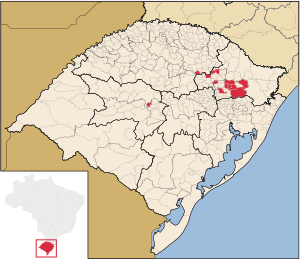
From the late 1800s to the mid-1900s, millions of Italians settled in Argentina, Uruguay, southern Brazil, Venezuela, Canada, and the United States. They created a strong Italian presence there.
In some places, Italian communities still use versions of regional languages of Italy. For example, in Rio Grande do Sul, Brazil, people speak Talian, which comes from the Venetian dialect. The town of Chipilo in Mexico also uses a form of Venetian from the 19th century. Other examples include Cocoliche, a mix of Italian and Spanish once spoken in Argentina, and Lunfardo. The Rioplatense Spanish dialect spoken in Argentina and Uruguay today has been greatly influenced by Italian.
Italian as a Global Language
Starting in the late Middle Ages, Italian language variations (especially Tuscan and Venetian) replaced Latin as the main language for trade in much of Europe and the Mediterranean. These variations became stronger during the Renaissance because of Italy's power and the rise of humanism and the arts.
During that time, Italy had a huge artistic influence across Europe. It was common for educated gentlemen to go on a "Grand Tour" to Italy to see its historical sites and art. So, learning some Italian became expected. For example, the English poet John Milton wrote some of his early poems in Italian.
Within the Catholic Church, many church leaders know Italian. It is sometimes used instead of Latin in official documents.
Italian words are still used in many languages today, especially in art and music (like classical music and opera), in design and fashion, in some sports like football, and especially for food terms.
Images for kids
-
Silver coin minted in Corfinium during the Social War (91–87 BC), displaying the inscription ITALIA on the verge of the personification of Italy, represented as a goddess with laurel wreath
-
Genetic principal component analysis of the Italian population with other populations
-
Ethnolinguistic map of Italy in the Iron Age, before the Roman expansion and conquest of Italy
-
Ancient Greek colonies and their dialect groupings in Magna Graecia.
Northwest Doric Achaean Doric Doric proper Ionic -
Augustus, who created for the first time an administrative region called Italia with inhabitants called "Italicus populus"; for this reason historians called him Father of Italians.
-
Odoacer, the first King of Italy
-
Leonardo da Vinci, a polymath of the High Renaissance who was active as a painter, draughtsman, engineer, scientist, theorist, sculptor, and architect
-
Galileo Galilei, an astronomer, physicist, engineer, and polymath, played a major role in the Scientific Revolution. He is considered the "father" of observational astronomy, modern physics, the scientific method, and modern science.
-
The Pantheon and the Fontana del Pantheon. Roman relics and Roman culture are important symbols in Italy.
-
Bologna University, established in AD 1088, is the world's oldest university in continuous operation.
-
Spaghetti alla carbonara
-
Niccolò Machiavelli, the founder of modern political science and ethics
-
Benedetto Croce (left) and Giovanni Gentile (right), the two greatest exponents of the Italian idealism
-
Dante Alighieri, one of the greatest poets of the Middle Ages. His epic poem The Divine Comedy ranks among the finest works of world literature.
-
Alessandro Manzoni is famous for the novel The Betrothed (1827), generally ranked among the masterpieces of world literature.
-
Dario Fo, one of the most widely performed playwrights in modern theatre, received international acclaim for his highly improvisational style. He was awarded the Nobel Prize for Literature in 1997.
-
Bartolomeo Cristofori, the inventor of the piano
-
Luciano Pavarotti, considered one of the finest tenors of the 20th century and the "King of the High Cs"
-
Giorgio Moroder, pioneer of Italo disco and electronic dance music, is known as the "Father of disco".
-
Federico Fellini, considered one of the most influential and widely revered filmmakers in the history of cinema
-
Vittorio De Sica, one of the world's most acclaimed and influential filmmakers of all time
-
Sergio Leone, widely regarded as one of the most influential directors in the history of cinema
-
Stefano Gabbana (left) and Domenico Dolce (right)
-
Ernesto Teodoro Moneta was awarded the Nobel Prize for Peace in 1907. He adopted the motto In varietate unitas! which later inspired Motto of the European Union.
-
Luigi Pirandello. He was awarded the 1934 Nobel Prize in Literature. Pirandello's tragic farces are often seen as forerunners of the Theatre of the Absurd.
-
Guglielmo Marconi, inventor and electrical engineer, known for his creation of a practical radio wave-based wireless telegraph system. This led to Marconi being credited as the inventor of radio, and he won the 1909 Nobel Prize in Physics "in recognition of their contributions to the development of wireless telegraphy".
-
Enrico Fermi, creator of the world's first nuclear reactor. He has been called the "architect of the nuclear age" and the "architect of the atomic bomb".
-
Percent of inhabitants with Italian native tongue in Croatia's and Slovenia's Istria
-
Italy and its colonial possessions in 1940
-
Italian Secondary School in Rijeka/Fiume, Croatia
-
Municipalities where Talian is co-official in Rio Grande do Sul, Brazil
-
Trilingual sign in San Francisco, Córdoba, Argentina, in Spanish, Italian and Piedmontese
See Also
 In Spanish: Pueblo italiano para niños
In Spanish: Pueblo italiano para niños
- Demographics of Italy
- Sicilians
- Sardinians
- Ladins
- List of Italians
- List of Sardinians
- List of Sicilians
- Sammarinese


